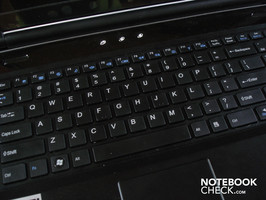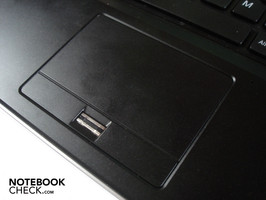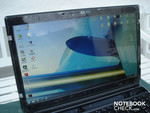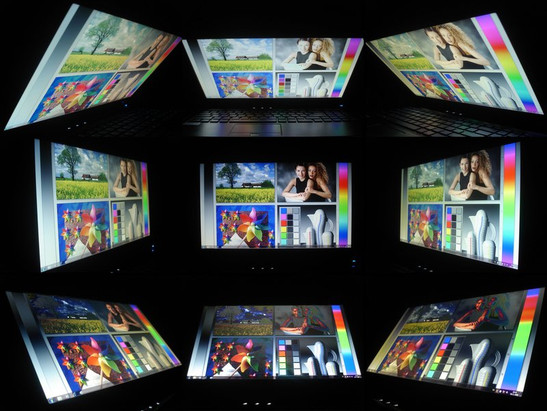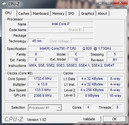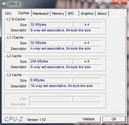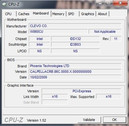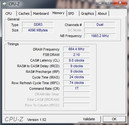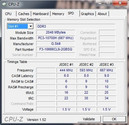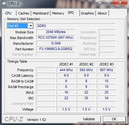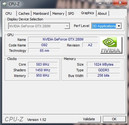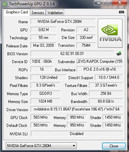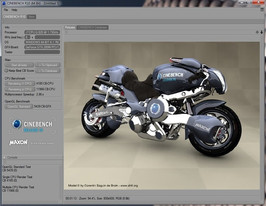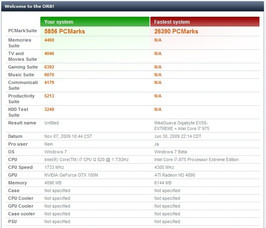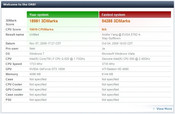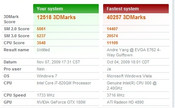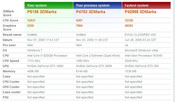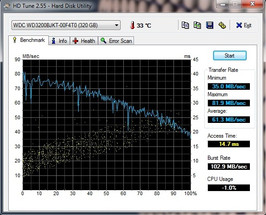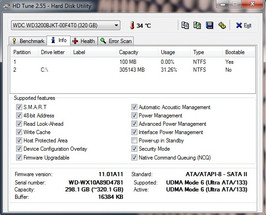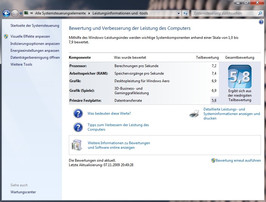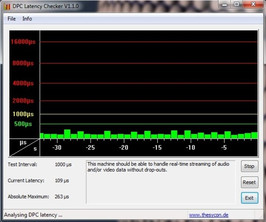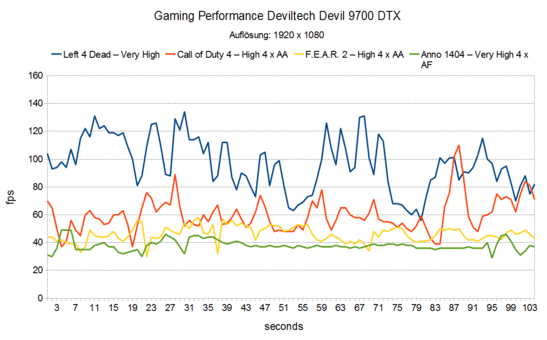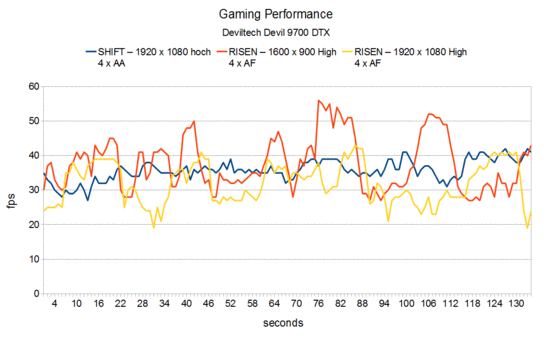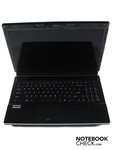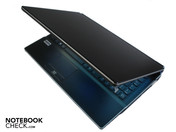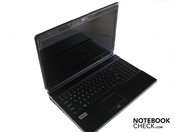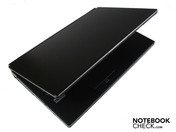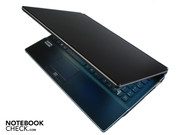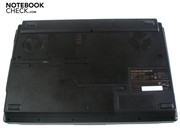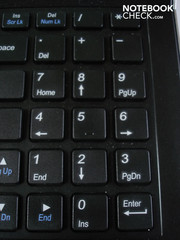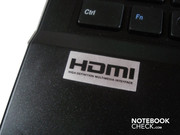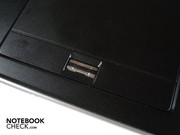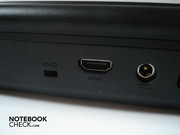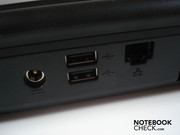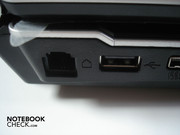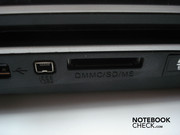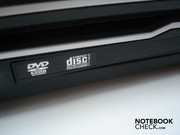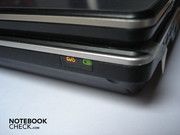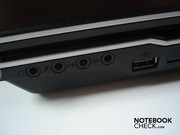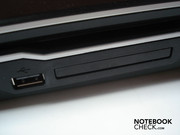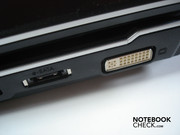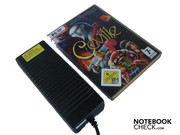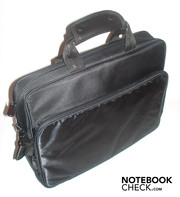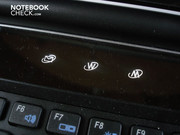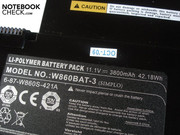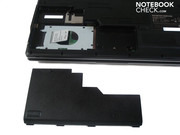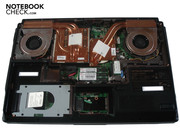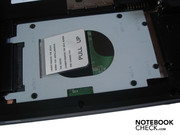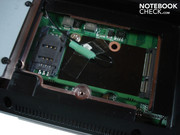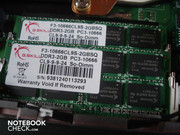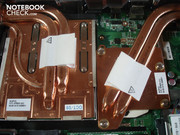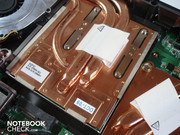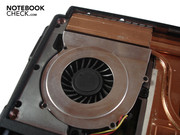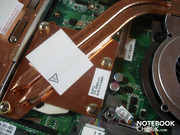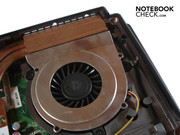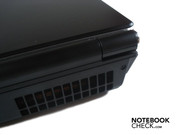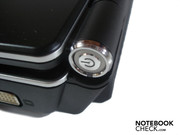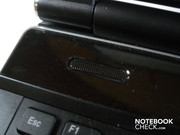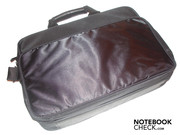Review Deviltech Devil 9700 DTX (W860CU) Gaming Notebook
The Gaming Devil?
Deviltech probably has the fastest 15.6 inch gaming notebook in the world in its range with the Devil 9700 DTX. Intel's Core i7-820QM and Nvidia's GeForce GTX 280M don't only promise an exceptionally good gaming performance but also put a high demand on the cooling at the same time. If the notebook, based on Clevo's W860CU barebone, can deal with this expectation is clarified in our comprehensive review.
As known from Deviltech, the Devil 9700 DTX can be configured in many aspects. Hence, the 15.6 inch display is available with either a resolution of 1600x900 or with a resolution of 1920 x 1080 for a surcharge of 59 euro. Intel's brandnew mobile Core i7 is used as the processor. Whilst a Core i7-720QM (1.60 - 2.80 GHz, 6 MByte L3 cache) does its job in the basic configuration, the customer can also select a Core i7-820QM (1.73 - 3.06 GHZ, 8 MByte L3 cache) for an extra 185 euro or a Core i7-920XM (2.00 - 3.20 GHz, 6 MByte L3 cache) for a steep surcharge of 669 euro.
The graphic card is made by Nvidia. The GeForce GTX 260M is standardly used, but for a fair surcharge of 59 euro Deviltech builds in the very fast GeForce GTX 280M, both with a GByte DDR3 VRAM. The DDR3 1333 RAM reaches from two to a maximum of eight GBytes, the hard disk capacity from 250 up to 640 GBytes (5400 or 7200 rpm) in HDDs and from 80 up to 250 GBytes in SSDs. In regards to the drive, Deviltech offers a normal DVD burner, a BluRay drive (plus 119 euro) or a BluRay burner (plus 299 euro).
A gigabit LAN modem and Bluetooth are already included in the basic configuration, WLAN is charged extra. Windows 7 is available in all its variations as the operating system. There is a two year warranty. For a surcharge of 150 euro, the warranty can be extended to three years if desired.
Our prototype with a FullHD display, Core i7-820QM, GeForce GTX 280M, four GBytes RAM, a 320 GByte hard disk, a DVD burner and Windows 7 Home Premium 64bit adds up to a proud price of 1875 euro. The Devil 9700 DTX has a price of 1389 euro in the basic configuration.
Case
The black case, based on Clevo's W860CU barebone, strongly resembles its big brother, W870CU (for example in mySN's XMG7.c). The matt surfaces make a high-end impression (despite plastic) and barely smudge even after a longer handling. In opposition to the just massive Alienware M15x, the 9700 DTX looks significantly compacter with its size of 370 x 260 x 42 mm (width x depth x height) and a weight of 3470 grams. A further bonus is the high case stability. Regardless if it's the upper or bottom side, the 9700 DTX barely yields at stronger pressure. Only the display frame can be depressed obviously in the area between the hinges.
Apart from that, the workmanship is excellent. We couldn't find anything to complain about, except for the (due to construction) hard edge between the notebook's upper side and the lateral edges. The notebook presents itself as simple and timeless in design and fits in every surrounding perfectly. Finally, the hinges are stable and do their work reliably and quietly.
Configuration
Connectivity
There aren't many 15" notebooks that bid such a comprehensive connectivity as it can be found in the 9700 DTX. Let's start with the rear that has a Kensington lock, a HDMI-out, DC-in, two USB 2.0 ports and a RJ-45 gigabit LAN. A RJ-11 modem, an USB 2.0 and a Firewire port follow on the left. A 7-in-1 cardreader and a DVD burner are beside this. The right discloses four audio sockets, a further USB 2.0 port, an ExpressCard 54mm slot, eSATA and DVI. The package is rounded off with a Bluetooth 2.1 for the wireless side.
The interface distribution appealed to us. Gamers connect all equipment, such as the adapter, the network, a mouse and eventually an external monitor, to the rear. The user merely needs the right side edge for external loudspeakers or a headset. Because the audio sockets have been placed in the far front, the correlating cables might restrict the mouse's freedom of movement a bit when they're used on the right.
The Devil 9700 DTX also has an integrated microphone, a two megapixel webcam and a fingerprint scanner.
Software and Supplies
Fortunately, the 9700 DTX's software installation turns out rather fundamental. On the one hand, this has the advantage that resource gluttons haven't been implanted, which could pull the system start and the work velocity down. On the other hand, the user doesn't have to spend a long time with de-installing superfluous ballast.
A highlight of the supplies is definitely the black notebook case that is included in the scope of delivery and that makes stable and high-end impression. However, it doesn't have much to offer.
Input Devices
Keyboard
The 9700 DTX's key size is pleasant. The keyboard is fairly easy to clean because of the space between the keys. However, it yields slightly in the center at a stronger pressure, but the keyboard is very stable towards the edges and is convincing with a distinct pressure point. The user doesn't have to forgo on a separate numerical block. The verdict about the layout is a bit difficult because our prototype has been equipped with an English key arrangement. But the English layout at least was very felicitous. Various comfort functions can naturally be triggered via Fn key combinations. Among others, enabling/disabling the touchpad, display, sound, WLAN and Bluetooth. The controls of volume and brightness, as well as managing several displays join in on this.
Touchpad
The slightly submerged touchpad, kept in the case's color, has been executed faultlessly. The smooth surface provides for excellent gliding traits on the one side. On the other, the touchpad proves to be very precise. In return, the scroll bars presented themselves as a bit finicky. The horizontal size of the touchpad is alright, but it could have used a lot more area vertically. Finally, the touchpad keys have a stiff but, unfortunately, somewhat indistinct pressure point.
Display
The 15.6 inch display of our prototype has a FullHD resolution of 1920 x 1080 pixels and a 16:9 format. The display's values are more than just impressive. Already the average luminosity of a very good 247.4 cd/m2 is inspiring. The low black value of 0.43 cd/m2 and the high contrast of 623:1 are still looking for equals amongst gaming notebooks. Only few displays, such as the Alienware M15x or the mySN XMG7.c can keep up with this.
| |||||||||||||||||||||||||
Brightness Distribution: 82 %
Center on Battery: 268 cd/m²
Contrast: 623:1 (Black: 0.43 cd/m²)
We especially liked the intense and true-to-life looking colors. The display is suitable for all conceivable application fields, no matter if office, movies or gaming. The display's only drawback is its reflective coating. If the display brightness (that doesn't decrease in battery mode) wasn't so high, you wouldn't see anything outside in strong sunlight.
Performance
Deviltech hasn't skimped with the components and built just about the best and most efficient hardware currently available into the Devil 9700 DTX.
The CPU is from Intel and is called 820QM. The 820QM is currently the second fastest CPU of Intel's new mobile Core i7 range. The Core i7 doesn't only have (like its predecessor Core 2) an L2 cache but also an L3 cache. It adds up to a generous eight MBytes in the 820QM. The special thing about it is the Turbo Boost function with which the processor automatically overclocks from 1.73 to up to 3.06 GHz when required. Thus, the power consumption is kept within limits in idle mode (maximum TDP 45 watts) on the one side and on the other, a sufficient amount of computing power is available under load. Another highlight of the Core i7 is its Hyper Threading Technology. Via Hyper Threading, four additional cores are replicated to the Core i7's four existing cores, which is why the 820QM pretends to be an eight core CPU in the task manager. This technology isn't new. It has been already used in the Pentium IV, for instance, but was badly received among developers. The situation doesn't look much better in games today. Many applications benefit considerably from every additional core, though.
But enough about the processor, let's get to the graphic card. Deviltech uses Nvidia's currently fastest single chip GPU, the GeForce GTX 280M. Technically, the GTX 280M is based on the G92b core and therefore is only a beefed up version of the GeForce 9800M GTX. So, it's not related to the desktop GTX 280. A few further facts: The GTX 280M is manufactured in a 55nm structure width and has 128 stream processors and 754 million transistors. It supports both DirectX 10.0 as well as PhysX. Thanks to the Pure Video HD technology, the CPU is unloaded at computing high resolution video material. The GTX 280M is (actually) only suitable for bigger notebooks because of the graphic card's high power consumption of 75 watts. A refined and efficient cooling is definitely necessary. Deviltech allows the GTX 280M to run close to its maximum clock rate with 583 MHz (core), 950 MHz (memory) and 1450 MHz (shader). This way, it's assured that velocity isn't wasted unnecessarily.
Apart from that, there is also a four GByte DDR3 1333 RAM (2x 2048 MByte) built into the Devil 9700 DTX. The mainboard can address a maximum of up to eight GBytes. Lastly, Windows 7 Home Premium serves as the operating system. The entire memory capacity is available due to the 64bit version.
Time to take a closer look at the real component performance. Intel's i7-820QM achieves an excellent 4185 points in the single-core and 11966 points in the multi-core rendering of Cinebench R10. In comparison, Intel's Core 2 Extreme QX9300, which had been overclocked in the test of Alienware's M17x to 3.06 GHz, computed about as fast with 4357 points in the single-core and 11176 points in the multi-core rendering. The Core i7-820QM with 5856 points is quite a bit faster than the QX9300 with its 4902 points in the PCMark Vantage.
We decided to use the weaker GeForce GTX 260M (in the Alienware M15x) for comparing the graphic-biased benchmarks in order to see just how big the distance to the GeForce GTX 280M really is. The difference of 18981 (GTX 280M) to 16611 (GTX 260M) is 2000 points in the 3DMark05. This difference decreases by about 1500 points in the 3DMark06: 12518 for the GTX 280M to 11080 for the GTX 260M. It's "only" about 500 points in the 3DMark Vantage with 6156 (GTX 280M) to 5685 (GTX 260M).
The Devil 9700 DTX's 320 GByte hard disk comes from Western Digital and supplies good values. According to HDTune, the transfer rate ranges from 35.0 to 81.9 MB/s, whereas the average is a good 61.3 MB/s. There's nothing to criticize about the throughput rate of 102.9 MB/s, either. Even the access rate of 16.7 ms turns out well for a normal HDD.
Windows 7 performance index isn't very close to practical use but should be mentioned anyway. Both the CPU (7.2 points) and the RAM (7.4 points) scored very well. The graphic card follows close with 6.9 points. The hard disk slipped slightly with 5.8 points. However, other high-end notebooks achieve a similar hard disk rating.
The latencies under Windows are more interesting, though. If these are too high, it can come to problems at connecting external devices (for example sound crackling with external sound cards). The Devil 9700 DTX does exemplary well in this exercise: The latencies always remained within a harmless field of under 500µ, according to the DPC Latency Checker.
The application performance turns out excellent due to the Core i7-820QM and GeForce GTX 280M. The user gets a future-proof system that should have enough reserves for several years available with this combination. The Devil 9700 DTX doesn't show any weakness even in the most demanding benchmarks. Basically, the GTX 280M computes about 10% faster than the GeForce GTX 260M in the controlled benchmarks. We'll check the gaming situation in following.
| PCMark Vantage Result | 5856 points | |
Help | ||
| 3DMark 05 Standard | 18981 points | |
| 3DMark 06 Standard Score | 12518 points | |
| 3DMark Vantage P Result | 6156 points | |
Help | ||
Gaming Performance
Left 4 Dead
The performance might drop in weaker systems when dozens of zombies scrabble around on the screen in Left 4 Dead. Not so with the Devil 9700 DTX. The refresh rate never fell under 60 fps even in the FullHD resolution of 1920 x 1080 and very high details. An excellent 94.0 fps was reached on average. In our standard resolution of 1024 x 768 it was even far over 100 with 131.5 fps. The GeForce GTX 260M computes almost exactly 40 fps slower and achieves 92.0 fps.
Call of Duty 4
When this review is published, the ferveretly awaited descendant of one of the most successful computer games of all times will finally be available in stores: Modern Warfare 2. Whilst the critics are spewing with high values and Modern Warfare 2 will likely trigger the next discussion of violence in interactive media due to numerous disputed gaming scenes (e.g. the airport level), we unleashed the predecessor, Call of Duty 4, on the Devil 9700 DTX. Call of Duty 4 ran with a smooth 60.0 fps in the FullHD resolution, high details and 4xAA. The performance increased to a smooth as silk 78.8 fps in the resolution of 1280 x 1024 (with the same settings). The GeForce GTX 260M isn't much slower with 72.0 fps.
F.E.A.R. 2
Whilst Monolith's developers are secretly working on a new game (a new F.E.A.R.? A new No One Lives Forever?), F.E.A.R. 2 will still be cause of terror and fear for a while. The opponents could be hit even without the pretty slow motion effects at a resolution of 1920 x 1080, high details and 4xAA due to 45.7 fps. F.E.A.R. 2 awards a resolution decrease to 1280 x 1024 with an almost twofold refresh rate: 86.1 fps is more than just impressive. The GeForce GTX lags slightly behind with 69 fps.
Anno 1404
Anno 1404 is still a delight even after the probably hundredth benchmark runthrough thanks to its beautiful graphic. We were just as delighted about the 37.1 fps that the Devil 9700 DTX in its FullHD resolution, very high details and 4xAF was able to reach. Anno 1404 ran even smoother at a resolution of 1280 x 1024 with 52.7 fps. The GeForce GTX 260M lagged behind quite a bit in the latter resolution with an average of 42 fps.
Crysis
Now we come to the hardest test for the Devil 9700 DTX: Crysis, which ran quite smoothly at a resolution of 1024 x 768 and high details with 43.8 fps in the CPU and 48.6 fps in the GPU benchmark. The GeForce GTX 260M had to struggle a bit more and "only" achieved 36 fps in the CPU and 38 fps in the GPU benchmark. Even the GeForce 280M had its problems at a resolution of 1920 x 1080 because Crysis studdered noticeably with 23.3 fps in the CPU and with 24.8 fps in the GPU benchmark. The refresh rate settled to a reasonably smooth level of 29.6 fps in the CPU and 32.0 fps in the GPU runthrough at a resolution of 1600 x 900.
We'd like to note here that the Devil 9700 DTX's display has an excellent interpolation. Therefore, a reduction of resolution of 1920 x 1080 to 1600 x 900, for example, is barely noticed.
Shift
The popular Need for Speed series goes new ways thanks to the new developer, Slightly Mad Studios. Shift moves away from the very funny, but in the end inane, arcade race of older parts to a significantly more simulation-heavy driving performance. If the publisher, Electronic Arts, has made the right decision will still have to be seen. The Devil 9700 DTX also has to prove itself. The chic graphics by SHIFT has its price: An average of 35.8 fps in the FullHD resolution, high details and 4xAA are just still enough to bring the race cars precisely around the curves.
Risen
Piranha Bytes developers are trying to sooth old Gothic fans with Risen, after the completely screwed-up Gothic 3. In the tester's opinion, this has been more than just accomplished. The performance of the Devil 9700 DTX isn't as good at a resolution of 1920 x 1080, high details and AxAF: A skimpy 29.3 fps aren't by far enough to enjoy Risen properly. A resolution decrease to 1600 x 900 expresses itself in a well-playable 36.6 fps.
As the performance difference between the GeForce GTX 280M and the GeForce GTX 260M were only a marginal 10%, it's a higher 25% in the gaming benchmarks, whereas the GTX 280M's advantage ranges from 9% (Call of Duty 4) to a enormous 43% (Left 4 Dead) depending on the game.
In summary it can be said that the GeForce GTX 280M, together with Intel's Core i7-820QM is capable of displaying most games in high details and the FullHD resolution of 1920 x 1080 smoothly. The resolution has to be reduced to at least 1600 x 900 only for a few exceptions, such as Crysis or Risen, so that you're not faced with a quake party.
Thus, if you really want to call a FullHD display in the Devil 9700 DTX your own, you should definitely invest the fair surcharge of 59 euro and take the GeForce GTX 280M instead of the GeForce GTX 260M.
Emissions
System Noise
The biggest point of critique is the Devil 9700 DTX's high noise development. The fan already turns up to a very audible 41.4 dB(A) in idle mode. The fan's volume even increases to a disturbing 44.2 to 48.6 dB(A) under load. The DVD drive doesn't really constrain itself at DVD rendering with 42.3 dB(A), either. The Devil 9700 DTX therefore always disagreeably attracts attention. All evaluations were made at a distance of 15 cm.
Noise level
| Idle |
| 41.4 / 41.4 / 41.4 dB(A) |
| DVD |
| 42.3 / dB(A) |
| Load |
| 44.2 / 48.6 dB(A) |
 | ||
30 dB silent 40 dB(A) audible 50 dB(A) loud |
||
min: | ||
Temperature
In return, the temperature development doesn't give so much reason for complaint. Both the upper side with a maximum of 30.6°C, as well as the bottom with a maximum of 34.5°C stay very cool in idle mode (max. energy saving options, two hours of operating). The upper side warms up very evidently to 45.8°C and the bottom up to 46.8°C under load (one hour Furmark + Prime95), but the wrist rests always stay pleasantly cool with a maximum of 31.6°C. It could get a bit uncomfortable after a while if the Devil 9700 DTX is placed on the lap, though.
Especially the graphic card inside proves to be surprisingly low tempered. Around 39°C in idle mode and 71°C under full load are more than just impressive. The processor at least stays within a green field with about 50°C in idle mode. The processor, however, exposed a problem in our endurance test of several hours of load with Furmark + Prime. As soon as the Core i7's temperature surpassed 85°C, the processor throttled itself down to 1194 MHz and stayed at this rate for a few seconds (so that the CPU's temperature sunk to about 80°C). The clock rate and temperature increased again after a few seconds and this game started from the beginning. We couldn't record such a behavior in our benchmarks, though. The reason: Because even demanding applications or games barely ever load the system to 100%, the CPU doesn't heat up as much as under constant (artificial) full load.
(-) The maximum temperature on the upper side is 45.8 °C / 114 F, compared to the average of 40.5 °C / 105 F, ranging from 21.2 to 68.8 °C for the class Gaming.
(-) The bottom heats up to a maximum of 46.8 °C / 116 F, compared to the average of 43.3 °C / 110 F
(+) In idle usage, the average temperature for the upper side is 28.5 °C / 83 F, compared to the device average of 33.9 °C / 93 F.
(+) The palmrests and touchpad are cooler than skin temperature with a maximum of 31.6 °C / 88.9 F and are therefore cool to the touch.
(-) The average temperature of the palmrest area of similar devices was 28.9 °C / 84 F (-2.7 °C / -4.9 F).
Lautsprecher
The second biggest disappointment is the under-average sound quality of the built-in loudspeakers. The soundscape already seems very shallow in games. The bass is barely apparent and works very weak. The trebles also fray slightly in music and the sound is generally rather tinny. Therefore, we would advise halfway demanding buyers to definitely use external loudspeakers. Even inexpensive 2.0/2.1 brand name combos for less than 50 euro bid a better sound than the Devil 9700 DTX loudspeakers.
Battery Life
The lithium polymer battery with 42.18 Wh isn't capable of providing for acceptable runtimes despite its eight cells. Thus, the battery reaches just short of the one hour mark at minimum brightness and maximum energy savings mechanisms (BatteryEater Reader's test): 63 minutes are far too little even for a gaming notebook. A brightness increase to maximum and a change of the energy savings plan to "medium" barely make a difference at internet surfing with about 55 minutes. Above that, it's only a scanty 47 minutes at DVD rendering. The Devil 9700 DTX is already exhausted after 43 minutes under full load and disabled energy savings mechanisms (BatteryEater Classic test).
Summing up, the notebook, unsurprisingly, is mainly suitable as a desktop replacement and not so much as a mobile companion.
The notebook's power consumption turns out accordingly high. Whilst the components already treat themselves to a good 53.5 to 58.4 watts in idle mode, it's between 125.6 and an enormous 142.7 watts under load. In return, the consumption is flawless in standby (0.0 watt) and in a deactivated state (0.0 watt).
| Off / Standby | |
| Idle | |
| Load |
|
Key:
min: | |
Verdict
Generally, the Deviltech Devil 9700 DTX, based on Clevo's W860CU barebone, made a very good impression.
Except for the disappointing battery life, the mediocre loudspeakers and the high noise development, there's almost no reason for complaint.
Starting with the excellent application and gaming performance, which represents a class of its own due to Core i7-820QM and GeForce GTX 280M. Then follow the stable and well-manufactured case with its matt surfaces and its chic and timeless design. The vast connectivity and the supplies, as a high-end notebook case and the always cool wrist rests, were very pleasing.
But the biggest highlight is the excellent display. High brightness (247 cd/m2), strong contrast (623:1) and saturated colors distinguish the Devil 9700 DTX's display.
So, if you're looking for an efficient and high-end gaming notebook and aren't deterred by a loud fan noise, you'd make an excellent decision with the Deviltech Devil 9700 DTX.








